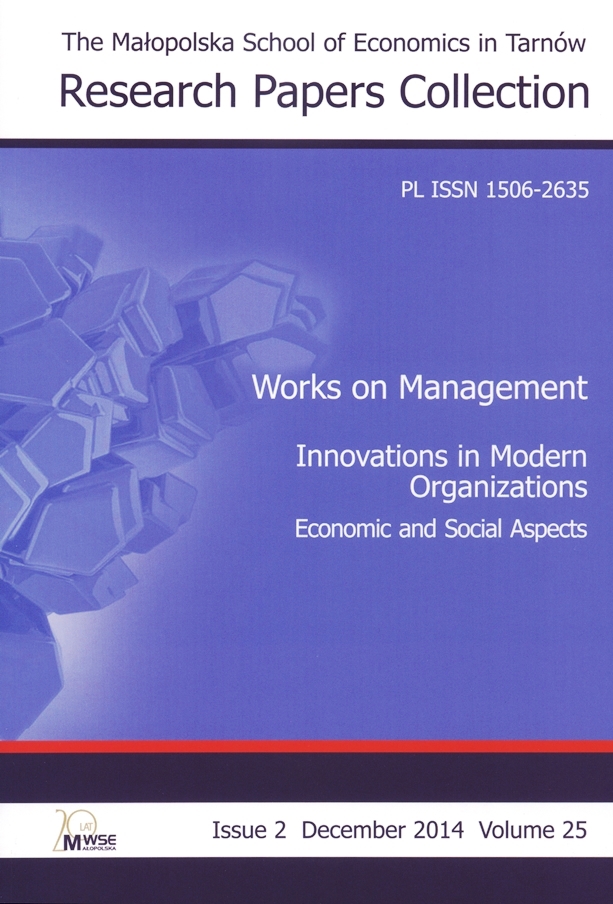Abstract
In order to lead employees to collectively innovate and thereby achieve business entrepreneurship, managers should project cultural values and implement them through appropriate human resource practices that affect the psychological cognition of employees. If they do it, the perceived organizational support of employees in relation to organizational behaviour-oriented innovation will increase. Human resource practices to support a culture of creativity and innovation of employees are essential for the company to achieve success and develop a sustainable competitive advantage. The aim of this paper is to identify the variables inherent in organizational culture capable of enhancing an organizational culture of innovation. It is believed that the ability of innovation can be learned and trained in the organization while diffusing cultural values, based on human resources management practices, capable of supporting an organizational behaviour by employees, oriented to innovation. The methods used in this article are analysis and synthesis, and methods of induction and deduction.
References
Ahmed, P. (1998). Culture and climate for innovation. European Journal of Innovation Management, 1 (1), 30–43.
View in Google Scholar
Amabile, T. M. (1988). A model of creativity and innovation in organizations. Research in Organizational Behavior, 10, 123–167.
View in Google Scholar
Barney, J. B. (1986). Organizational culture: Can it be a source of sustained competitive advantage? Academy of Management Review, 11 (3), 656–665.
View in Google Scholar
Çakar, N. D., Erturk, A. (2010). Comparing innovation capability of Small and Medium-Sized Enterprises: Examining the effects of organizational culture and empowerment. Journal of Small Business Management, 48 (3), 325–359.
View in Google Scholar
Chandler, G. N., Keller, C., Lyon, D. W. (2000). Unraveling the determinants and consequences of an innovation-supportive organizational culture. Entrepreneurship Theory and Practice, 59–76.
View in Google Scholar
Claver, E., Llopis, J., Garcia, D., Molina, H. (1998). Organizational Culture for Innovation and New Technological Behavior. The Journal of High Technology Management Research, 9 (1), 55–58.
View in Google Scholar
Covin, J. G., Slevin, D. P. (1991). A conceptual model of entrepreneurship as firm behavior. Entrepreneurship Theory and Practice, 16 (1), 7–25.
View in Google Scholar
Craig, J. B., Moores, K. (2006). A 10-year longitudinal investigation of strategy, systems, and environment on innovation in family firms. Family Business Review, 19 (1), 1–10.
View in Google Scholar
Damanpour, F. (1991). Organizational innovation: A meta-analysis of effects of determinants and moderators. Academy of Management Journal, 34 (3), 554–590.
View in Google Scholar
Day, G. S. (1994). The capabilities of market-driven organization. Journal of Marketing, 58 (4), 37–52.
View in Google Scholar
Deal, T. E., Kennedy, A. A. (1982). Corporate cultures: The rites and rituals of corporate life. Boston: Addison-Wesley.
View in Google Scholar
Freeman, J., Engel, J. S. (2007). Models of innovation: Startups and mature corporations. California Management Review, 50 (1), 94–119.
View in Google Scholar
Gerhart, B. (2009). How much does national culture constrain organizational culture? Management and Organization Review, 5 (2), 241–259.
View in Google Scholar
Gonzalez-Padron, T., Hult G. T., Calantone, R. (2008). Exploiting innovative opportunities in global purchasing: An assessment of ethical climate and relationship performance. Industrial Marketing Management, 37, 69–82.
View in Google Scholar
Gudmundson, D., Tower, C. B., Hartman, E. A. (2003). Innovation in small business: Culture and ownership structure do matter. Journal of Developmental Entrepreneurship, 8 (1), 1–17.
View in Google Scholar
Hauser, M. (1998). Organizational culture and innovativeness of firms: An integrated view. International Journal of Technology Management, 16 (1), 239–255.
View in Google Scholar
Hofstede, G. (1991). Cultures and organizations: Software of the mind. London: McGraw-Hill. ISBN 0077074742.
View in Google Scholar
Hurley, R. F., Hult, G. T. (1998). Innovation, market orientation, and organizational learning: An integration and empirical examination. Journal of Marketing, 62 (3), 42–54.
View in Google Scholar
IBM Global Business Services. (2006). Expanding the innovation horizon: The global CEO study 2006 [online, accessed: 2014-06-16]. Retrieved from: http://www-935.ibm.com/services/au/bcs/html/bcs_ceostudy2006.
View in Google Scholar
html.
View in Google Scholar
Kanter, R. M. (2000). A culture of innovation. Executive Excellence, 17 (8), 10–11.
View in Google Scholar
Leskovar-Spacapan, G., Bastic, M. (2007). Differences in organizations’ innovation capability in transition economy: Internal aspect of the organizations’ strategic orientation. Technovation, 27, 533–546.
View in Google Scholar
OECD (1997). Oslo Manual: Proposed guidelines for collecting and interpreting technological innovation data. 2nd revised ed. Paris: OECD.
View in Google Scholar
Ogbonna, E., Harris, L. (2000). Leadership style, organizational culture and performance: Empirical evidence from UK companies. The International Journal of Human Resource Management, 11 (4), 766–788.
View in Google Scholar
O’Reilly, C. A., Chatman, J., Caldwell, D. F. (1991). People and organizational culture: A profile comparison approach to assessing person-organization fit. Academy of Management Journal, 34 (3), 487–516.
View in Google Scholar
Slevin, D. P., Covin, J. G. (1990). Juggling entrepreneurial style and organizational structure: How to get your act together. Sloan Management Review, 31 (2), 43–54.
View in Google Scholar
Snell, S. A. (1992). Control theory in strategic human resource management: The mediating effect of administrative information. Academy of Management Journal, 35 (2), 292–327.
View in Google Scholar
Wang, S., Guidice, R. M., Tansky, J. W., Wang, Z. (2010). When R&D spending is not enough: The critical role of culture when you really want to innovate. Human Resource Management, 49 (4), 767–792.
View in Google Scholar
© Copyright by Małopolska School of Economics in Tarnów. The articles are available under the Creative Commons Attribution NonCommercial-NoDerivatives 4.0 International License


